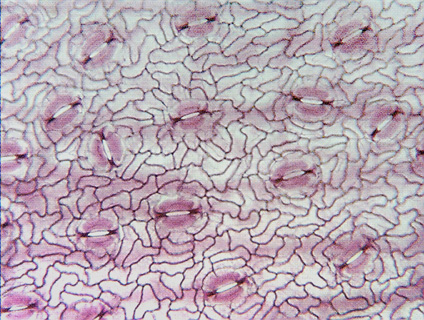 Fig.
10.3-2. Epidermal peel of cycad
leaf (Cycas rumphii). Ordinary epidermis cells in cycad leaves
typically have an angular
shape, often being trapezoidal. Notice that the guard cells and
stomatal pores here are very large.
Fig.
10.3-2. Epidermal peel of cycad
leaf (Cycas rumphii). Ordinary epidermis cells in cycad leaves
typically have an angular
shape, often being trapezoidal. Notice that the guard cells and
stomatal pores here are very large.
Stomatal density can be considered in terms of the number of stomata per square millimeter, which is a good measure of how permeable the epidermis is to the movement of carbon dioxide, oxygen and water. But density can also be considered in the number of cells that become stomatal complex cells as a percentage of all the cells in the epidermis (for example, if the number is 50% of all epidermal cells -- that would indicate half of all cells differentiate into guard cells or subsidiary cells; if it is only 5%. then only 1 cell in 20 do so).
The stomatal density in terms of stomata per square millimeter is high in this species, but as a percentage of all epidermal cells, it is low.